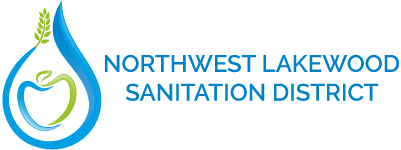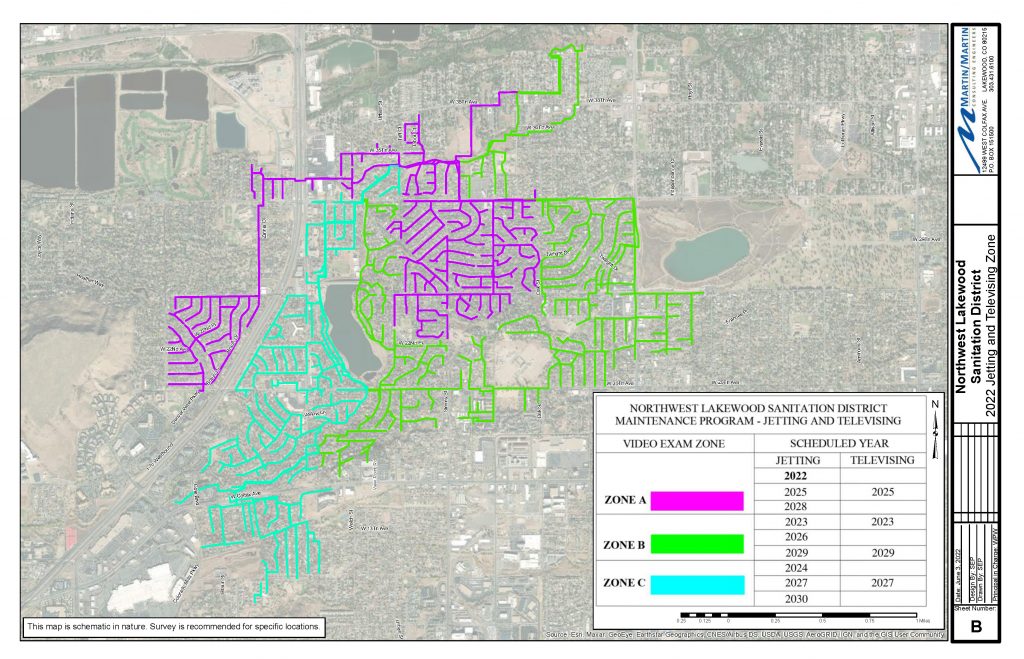GENERAL INFORMATION
The Northwest Lakewood Sanitation District was organized in 1954 and approved by the District Court of Jefferson County on July 26, 1954, under what is now known as the Special District Act.
The District provides sanitary sewer service to both residential and commercial properties. The sewer system is a network of sewer lines, manholes, and other structures used to collect wastewater and transport it to a treatment plant.
The District is generally located between 38th Avenue (north side), 10th Avenue (south side), Kipling Street (east side) and I-70 (west side). There are properties outside of these general boundaries, including some property west of I-70, south of 6th Avenue and east of Kipling. The District covers approximately six (6) square miles within Lakewood, Wheat Ridge, and unincorporated Jefferson County (see map).
No. The District system is a collection system only. The District maintained its own treatment plant until September 2004. At that time the plant was shut down and all wastewater treatment was transferred to Metro Water Recovery.
The District is governed by a five-member elected Board of Directors. The Board sets policy, rates fees and charges, and governs the District on behalf of the community. The Board demands a high standard of wastewater collection. The Board is tasked with governance and has the authority to manage, control, and supervise all business affairs of the District. The Board also is responsible for strategic planning for the future.
UNDERSTANDING YOUR BILL
The quarterly bill will provide the following information:
- The individual(s) responsible for the payment of the invoice and the service address related to the invoice.
- The account balance for the property beginning with the previous balance, any payments made, any current charges to the account including a description of each charge, and the total balance due on the account.
- The period covered for the services, information on how to pay the bill, and any additional information or notices from the District.
There also is a payment stub on the bottom of the invoice that customers can use for remitting mail-in payments.
The voter-approved property mill levy revenues are used for the general operation of the District and primarily for the payment of the wastewater treatment charges which are generally at least 75% of the budgeted operating expenditures.
The quarterly fee, also known as the Facilities Renovation and Services Fee (FRSF), is primarily for the maintenance, rehabilitation, and replacement of the existing system. If funds are available, they may also be used for the Enterprise Fund for services as necessary.
As part of the Annual Budget approval process, the Board will review the FRSF and determine if any changes are needed for the following year based on the estimated costs of operations and capital projects that are deemed necessary.
Residential, tax-exempt, and commercial properties are billed based on the Single-Family Residential Equivalent (SFRE) for the property. The SFRE for any property is based on the size of the water meter used to service the property. Most residential properties are billed at 1 SFRE and the billing rate per SFRE is $400.00 per year or $100.00 per quarter. Typically, commercial properties will have water meter taps that are ¾ inch or greater and these are billed at higher SFRE rates that can range from 2 SFRE ($800.00/year) to 86 SFRE ($34,400.00 per year) or more.
Most of the existing system was constructed in the mid to late 1950’s using Vitrified Clay Pipe (VCP) which was the standard at that time and had a life expectancy of 60-75 years. The system is now approaching the end of the useful life and the Vitrified Clay Pipes need to either be replaced or refurbished. Therefore, the District has established a rigorous maintenance and capital improvements program that is revised annually based on the needs of the system. As previously stated, the funds received from this fee are the funds that are used to make these repairs.
Quarterly bills are always prepared on the last day of a calendar year quarter and are for the following three (3) months or calendar year quarter. For example, on December 31 of a calendar year the bill for the next quarter, or the three (3) months of January, February, and March, is prepared and sent out to all District customers. If bills are sent by the US Postal Service, they are generally received by the end of the first week of the quarter. If the District is provided with an e-mail address to send bills electronically, then you should receive your new bill within the first day or so of the quarter.
Payments are due on or before the 5th day of the second month of the quarter. For example, bills dated December 31 for the first quarter of a calendar year are due on or before February 5. Any account for which the payments are not received timely are then assessed a late fee on or about the 11th of that month. Late fees are $15.00.
The District has several options for paying your bill.
You may mail your personal check, cashier’s check, or money order to the District to:
141 Union Blvd., Suite 150
Lakewood, CO 80228
You may also pay using Xpress Bill Pay, our online bill payment service.
To pay your bill, access Xpress Bill Pay from the District’s website. You can also contact the Xpress Bill Pay Customer Service department at 800-766-2350 if you need assistance with your account or payment.
Sewer bills may be put into a tenant’s name if authorized in writing by the property owner or property manager. Sewer service is provided to the property, and the property owner is ultimately responsible for any and all charges incurred to service the property. The owner is notified if the bill is not being paid or if legal actions are contemplated to collect delinquent accounts. Xpress Bill Pay is a great option for owners, property managers and tenants. The owner can create an account on Xpress Bill Pay and allow access to the tenants of the property to create a sub-account to make payments and view the bill. Unpaid sewer service charges constitute a lien against the property served.
SEWER LINE MAINTENANCE AND BACKUPS
It’s important to know that including all plumbing throughout the home and the sewer (wastewater) line extending from the property owner’s home to the District’s main line, including the actual tap connection to the District’s main line, is owned and maintained by the property owner. It’s at the point of connection (usually under the street) where the home pipeline connects to the wastewater main pipeline that the District takes over the responsibility for maintaining the wastewater pipeline. That is why it’s so important to NEVER put any oils, fats, or grease down the drain or flush anything but human waste and toilet paper down the toilet.
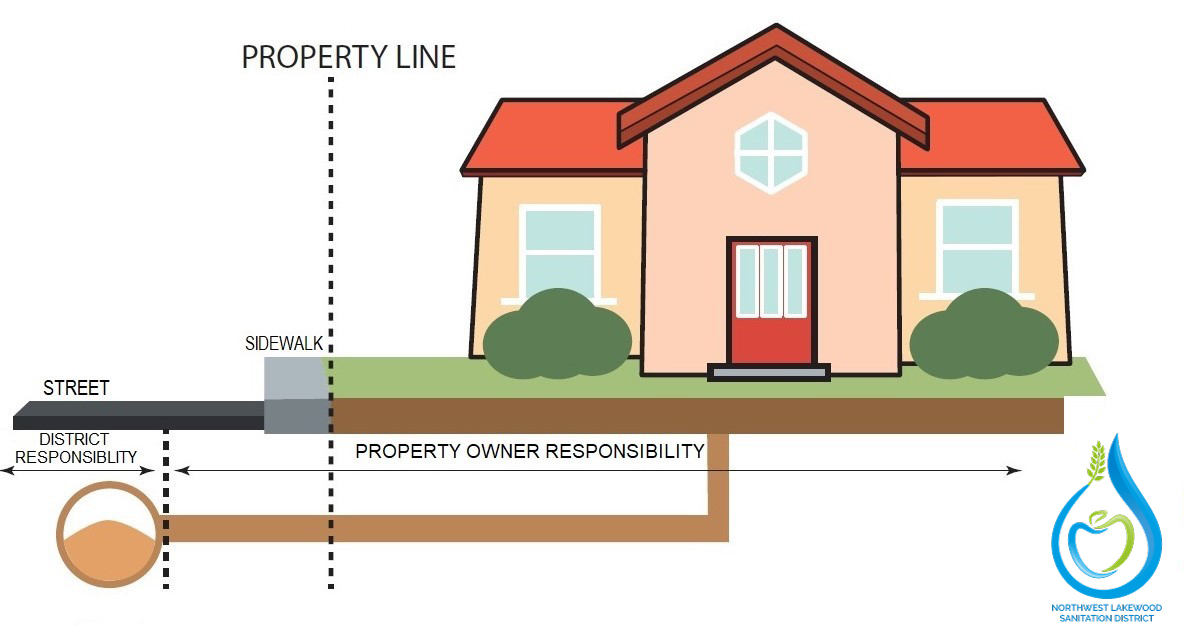
Under the District’s current maintenance program, approximately one-third (1/3) of the system is cleaned each year. The District uses high pressure water cleaning, tree root growth removal, and other methods to ensure that our lines are clear of debris to keep the system running smoothly. In addition, the District conducts Closed Circuit Television Video (CTTV) sewer inspection of one-third (1/3) of the system every other year (in other words, the entire system is surveilled every six years).
When a sewer backup or other problem occurs, in most cases it will not be obvious whether the problem area is in the property owner’s sewer or the public main line.
First, check to see if your neighbors are backing up too. If not, the blockage is most likely in your sewer line. If you believe there is a blockage in the public main line, contact the Northwest Lakewood Sanitation District at 303-987-0835 during regular business hours or 877-854-5453 after hours.
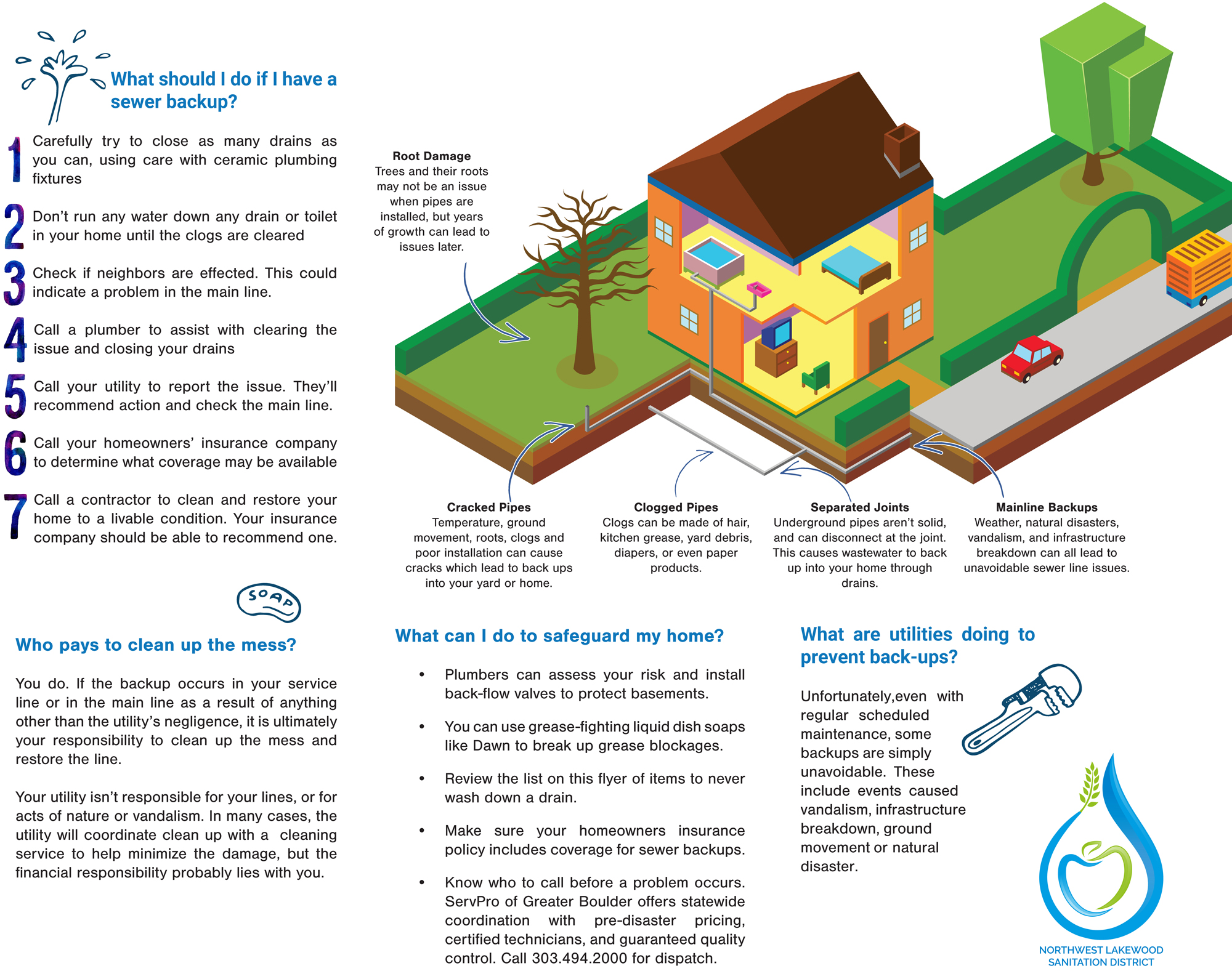
Download the Cover Your Flush brochure here to learn more about sewer backups.
The District will come out to inspect the public main line free of charge. If a problem is found within the public main line, it will be repaired as soon as possible. If the public main line is found to be clear, the property owner will be informed that the blockage is probably in the sewer line. In this case, the property owner is responsible for maintenance or repair.
If a backup occurs in your home due to a blockage in the property owner’s sewer line or lateral, it is their responsibility to clean up any damage from the backup. That’s why it is so important to let everyone in your home know what not to flush and put down the drain. In the event of a blockage in the District’s main line that results in a backup into private property, the District may be responsible for the cleanup but only if the District was negligent in causing the backup to occur.
The District always urges our customers to obtain insurance coverage for sewer backups. Please check your policy or call your agent to be sure you are covered should a mishap occur. Not all homeowners’ insurance policies will cover costs incurred with sewer backing up in their home.
Most sewer backups occur because the line is plugged with grease or roots or a combination of grease and roots. Backups are also caused by a sag (or belly) in the property owner’s sewer line that has collapsed. Never place anything in the system other than toilet tissue. Products like baby wipes and rags and other products labeled “flushable” frequently cause backups because they do not disperse like bathroom tissue.
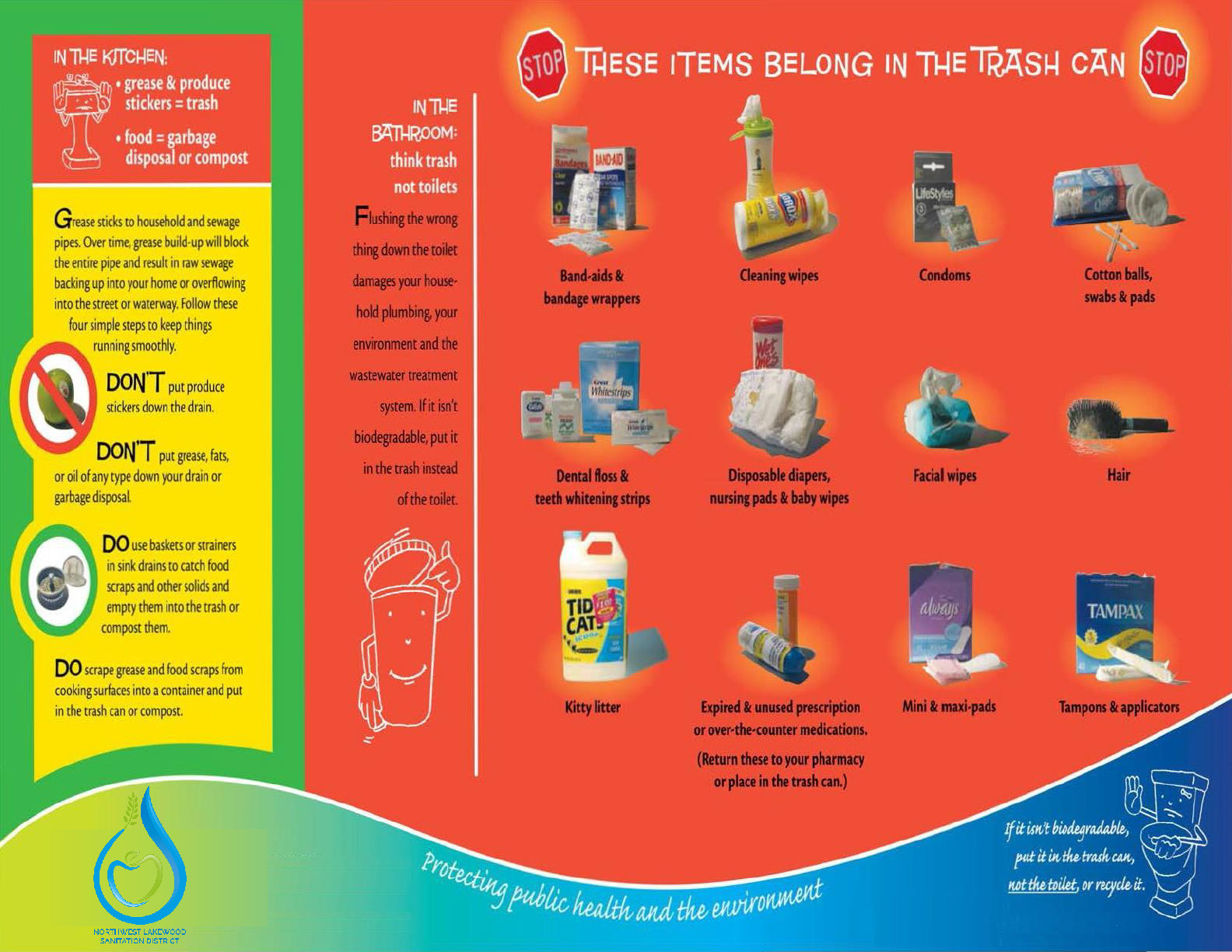
FOG refers specifically to Fats, Oils and Grease entering the sewer system. When you put cooking waste like grease, oil and food scraps down the drain they are usually warm and free flowing. However, shortly thereafter, they cool and harden and adhere to the pipe wall. A FOG buildup will eventually cause a backup.
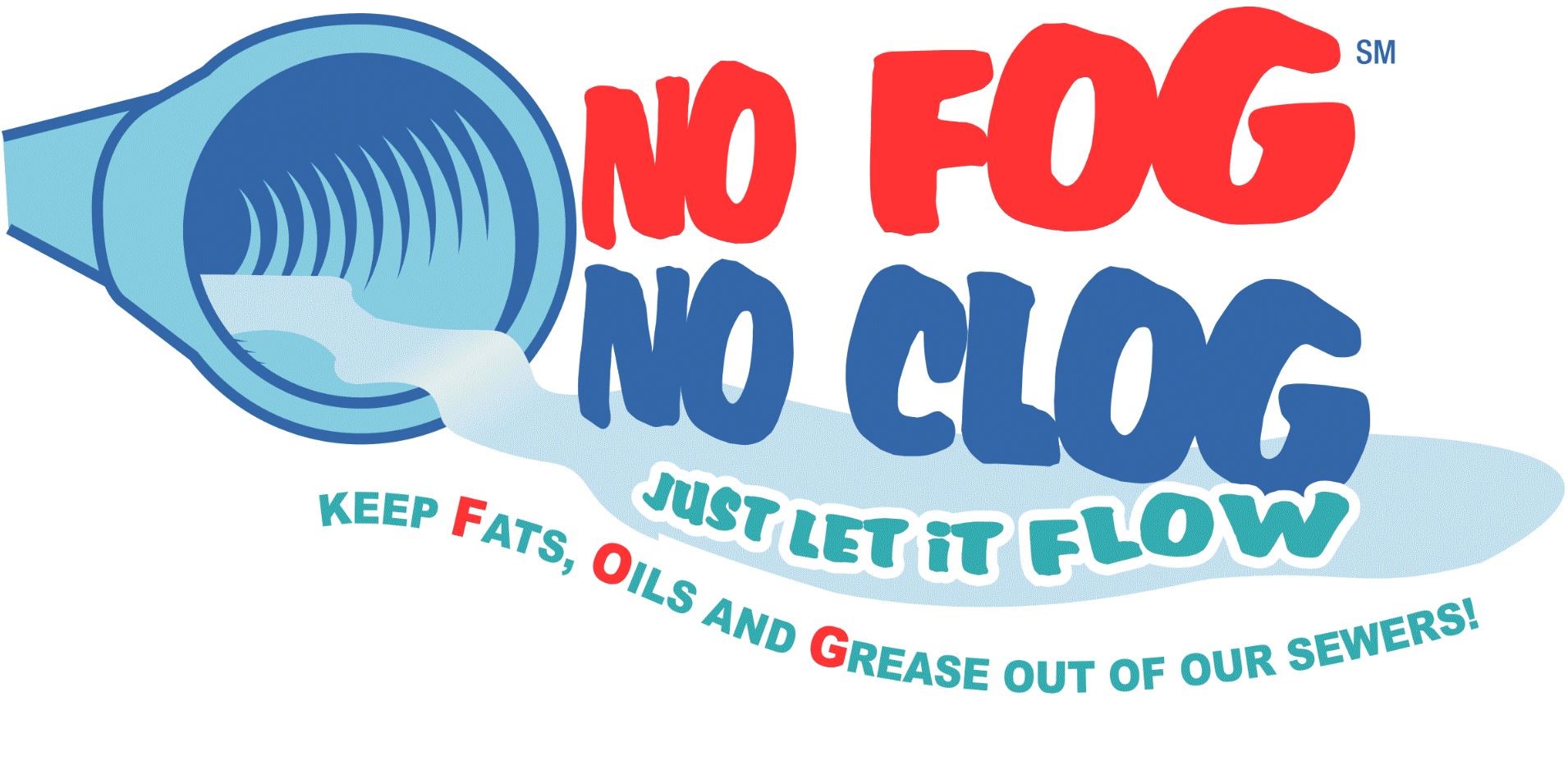
WASTEWATER, INFRASTRUCTURE & EASEMENTS
Wastewater or sewage is the byproduct of many uses of water such as showering, dishwashing, laundry and flushing the toilet. After the water has been used, it enters the household’s wastewater line and after it connects to the District’s main wastewater line, the wastewater flows to a wastewater treatment plant.
Learn more about sanitary sewer systems here.
Pollutants must be removed from the wastewater to help protect the environment and public health. When water is used in our community, the water becomes contaminated with human waste. If left untreated, these pollutants would negatively affect our health, water quality and environment.
Sanitary sewer systems are the public sewer main lines and manholes that collect and transport wastewater.
The manhole’s circular metal lid, usually located in the middle (sometimes to the side) of the street, is for access to the public main line. Only authorized District personnel can remove the manhole cover and enter the manhole. Typically, these lids are sealed shut so that odors are not released and so that water filtration and debris entering the system is prevented.
Please report the occurrence to the District immediately at 303-987-0835 during regular business hours or call the Emergency Number at 877-854-5453 if after hours.
When a public sewer line crosses private property, the property owner grants the Northwest Lakewood Sanitation District an easement, which is an interest in the property that enables the District to operate and maintain the sewer line and related facilities within the easement area. The District is usually granted a 25-foot-wide easement over the length of the sewer pipe line and related facilities.
The property owner continues to own the land and has only given up limited rights with respect to the portion of land used for the easement. Maintenance of the property within the easement is the responsibility of the property owner. The property owner continues to use the surface of the land as long as such use does not interfere with the District’s operations, maintenance, and repair of its facilities. The property owner’s use, however, usually does not entail the right to build a structure within the easement area.
The District may access its easements at any time. The District may, on occasion, authorize and have a Contractor perform specific tasks on the public main line inside an easement.
Easements are typically granted to the District with the understanding that the property owner may make improvements to the surface such as fences, asphalt paving, irrigation and lighting systems or similar improvements. However, if these improvements are required to be removed to maintain the underlying public main line, replacement is at the cost of the landowner. Structures are never allowed inside an easement.
An encroachment is an unauthorized physical intrusion into the limits of the easement area. The District may require that any unauthorized encroachments be removed at the property owner’s expense.
The property owner may be faced with the costs of removal and any associated damages resulting from unauthorized structures or improvements on land subject to an easement.
OTHER
Call 811 or visit Colorado811.org at least 3 business days before you dig. It is Colorado law that all who wish to dig must first give utilities up to three business days to locate any facilities (gas and electric, communications, and cable) which may be impacted by excavation. 811 sends a message to all utilities which service your property. Once your lines are marked, you will know their approximate location and you can dig safely. Knowing what’ s below will protect you, your family and your neighbors. So please remember, Call 811 Before You Dig!
Never put hazardous household chemicals down the drain, toilet, or into the trash. Residents of Jefferson County can dispose of hazardous materials at Rooney Road Recycling Center at 151 South Rooney Road, Golden, CO near the intersection of I-70, C-470 and West Colfax. The Center is open on Wednesdays and Saturdays from 8:00 a.m. to 2:00 p.m., by appointment. Book your appointment online.
For more information, visit the Rooney Road Recycling Center website.
No. Connecting sump pumps to the sanitary sewer is illegal.

